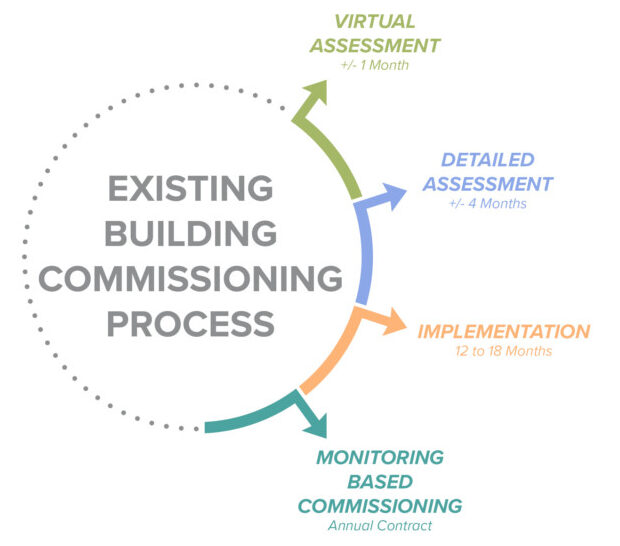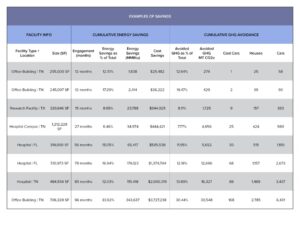SSR’s Four Phase Approach to Existing Building Commissioning
Most facilities are designed to operate at a certain level of performance. Over time, a facility’s performance may diminish due to age, improper maintenance, or worn-out equipment. Existing building commissioning (EBCx) provides an owner with a means to improve performance of existing buildings by finding ways to optimize existing systems and even replace older equipment with more energy efficient products. SSR offers a simple, four phase process to EBCx that is based on the tenets of Continuous Commissioning: virtual assessment, detailed assessment, implementation, and monitoring based commissioning (MBCx).

Virtual Assessment
The first phase of any existing building commissioning process is to perform a FREE virtual assessment. During this phase, SSR’s team sends a brief questionnaire to be completed by the building’s owner or facility manager. This questionnaire helps gather basic information about the building’s construction type, HVAC systems, controls, and utility bills. Based on the information, the potential for energy and cost savings are identified which helps determine whether a detailed assessment would be beneficial. This service is used to benchmark a facility/campus in terms of potential energy savings. There is NO COST for this assessment and typically takes about a month to review the data and prepare the potential savings.
Detailed Assessment
Should the owner decide that the facility is a candidate for the full EBCx process, the second phase is a detailed assessment. This is a more detailed, on-site investigation. After meeting with appropriate building staff, SSR’s team conducts a study of the building, including utility bills, facility drawings, and past and current operational issues. Specific and detailed energy measures are developed that apply to how the client is using their facility to improve efficiency and resolve problems utilizing existing equipment and without any expenditure. An actual building model is created and calibrated that represents the true building operation based on how the systems are programmed within the BAS. Specific energy conservation measures (ECMs) are applied to the model to get a more accurate energy and cost savings based on implementing the ECMs. A report is generated with detailed information on energy use and cost savings, simple payback and ROI, EnergyStar score, O&M issues, and opportunities for capital improvements, just to name a few. This phase usually takes four months to complete.
Implementation
The third step in the EBCx process is to implement the energy and cost savings measures identified in the detailed assessment report. Our team works with the facility staff to identify which measures will be implemented, develop a plan, and train staff on the specific findings and measures implemented. This typically includes measurement & verification (M&V) using IPMVP Option C. We also document improvements and savings and issue a final project report. This phase can take between 12 to 18 months depending on the number of measures being implemented. It is important to remember that these activities are not capital expenses or construction projects.
Monitoring Based Commissioning
The final phase in SSR’s approach to existing building commissioning is persistence or monitoring based commissioning. While not required, we recommend this approach to prevent building performance degradation and potentially continue to improve performance over time. This is an ongoing service that utilizes cloud-based Automatic Fault Detection and Diagnostic (AFDD) software. The use of this software allows our team to efficiently research historical and recent operating data to identify performance and efficiency issues; discover equipment and system performance issues before they cause unhappy users and tenants; and quickly and cost-effectively diagnosis problems to avoid costly and time-consuming trouble-shooting and investigative maintenance activities. Our monthly reports ensure installed systems are controlled correctly and the team is proactively finding and resolving issues before they become major problems. This is generally an annual contract or multi-year engagement.
Conclusion
Existing building commissioning is a proven process that can save an owner both energy consumption and dollars to the bottom line. While every facility is different, the cost savings and ROI can be significant. The table below shows some of the savings that SSR has been able to achieve for recent clients. If you think your facility would benefit from the results of these services, reach out today (info@ssr-inc.com) to get started on the free virtual assessment.









